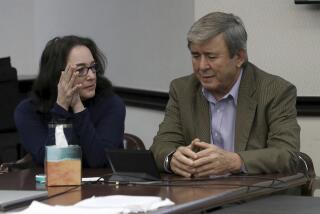Deputies Recall Chaotic Scene, Helpless Feeling
- Share via
SANTEE, Calif. — The bloody tableau facing San Diego County Sheriff’s Deputy Howard Kluge was the stuff of nightmares.
The bodies of children lay strewn like discarded toys. Their moans filled the air--cries of pain, pleas for help. Kluge’s conscience tugged hard, but he had no choice. He couldn’t help. Not yet. Not until he got to the gunman who caused the mayhem.
So he ignored the cries.
“It was the most helpless feeling in my life,” he said.
Kluge was among four deputies who were the first to arrive Monday morning on a grassy quad at Santana High School, where two students were shot dead and 13 people were wounded. A 15-year-old freshman, Charles Andrew Williams, is accused of the shootings. The deputies, and the first paramedics to arrive a few minutes later, recalled on Wednesday a scene that was emotionally wrenching, even for veterans of tragedy.
As students and teachers pointed him to the boys’ bathroom where shots had been fired, Kluge came across a student lying on the ground, bleeding from the chest, and a student teacher, shot in the side, propped up against a wall. Both cried for help.
“I told some people to put pressure on the wounds,” Kluge said. “That’s all I could do at the moment.”
Kluge rounded a building and came across a student lying face down on the grass, lifeless. A teacher draped herself over the young man in a vain attempt to protect him from further harm.
By the time Kluge made it to the bathroom, Deputies Ali Perez and Jack Smith were already there, out of breath from sprinting across campus. A fourth deputy, Pat Byrne, armed with a shotgun, had spotted Williams in the bathroom. Byrne, who served in Vietnam with the 4th Marine Regiment, had a clear shot at Williams but did not take it.
“I chose not to because he was in a nonthreatening position to me, and my three partners were pretty close to him. I kept the shotgun pointing down,” Byrne said.
There was no need to aim. Just four minutes after the officers arrived, Williams gave up.
“I saw the suspect with the gun in his hand behind a privacy wall,” Perez said. “He was holding the gun by the barrel and handing it out in a surrendering position.”
Perez, like Byrne, chose not to shoot. “I gave him a verbal command, and he dropped the weapon,” he said.
Smith rushed into the bathroom and kicked the pistol away. Two students lay on the floor beneath the urinals.
Perez ordered his partners to look for more suspects. That’s when Williams uttered the chilling quote repeated across the country: “It’s only me.”
Even before the officers had marched Williams away, the first firefighters and paramedics hurried into the quad, ignoring the normal practice of waiting for a crime scene to be declared safe.
Among the first was Capt. John Cincotta, who had a worry of his own: Both of his children attended the high school. What he found brought relief and disgust.
“Was I worried about my kids? Of course. I am there as a parent,” Cincotta said. “But if my crew saw me panic, then I am not controlling the scene. Every kid I looked at, I was relieved it wasn’t my son or daughter. But then I had to do my job. That’s hard.
“I was thinking about my kids the whole time.”
Robert Siemon, a firefighter and paramedic, recalls most of his actions, such as stepping over the handcuffed suspect, as a blur, fueled by adrenaline.
Siemon found Brian Zuckor, 14, shot in the back of the head in the bathroom. In a moment of decorum amid the disaster, the paramedic remembers moving the boy’s body away from the toilet stalls.
For the deputies who were taking Williams, meanwhile, the chaos had given way to surprise. The slightly built youth looked completely nonthreatening without the handgun, and “completely relaxed and calm,” one of the officers recalled.
“He struck me as just a child,” Perez said.
Later in the day, the boy seemed “upbeat, calm. He wasn’t upset at all. I believe he knew the gravity of the situation, but he was pretty nonchalant,” said Deputy J.T. Faulkner, who helped drive Williams from the Santee sheriff’s substation to Juvenile Hall at 4:30 p.m.
The only time Williams showed any emotion was after he arrived at Juvenile Hall.
“When we released him to the custody of the juvenile officer, he began crying and shaking a lot. He was in an oversized paper suit that made him look even smaller. That suit was shaking hard. I think at that point he understood the trouble he was in,” Faulkner said.
Williams never asked for anybody, Faulkner said, “not even his father or mother.”
*
Times staff writer Ken Ellingwood contributed to this report.
More to Read
Sign up for Essential California
The most important California stories and recommendations in your inbox every morning.
You may occasionally receive promotional content from the Los Angeles Times.












